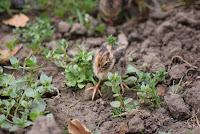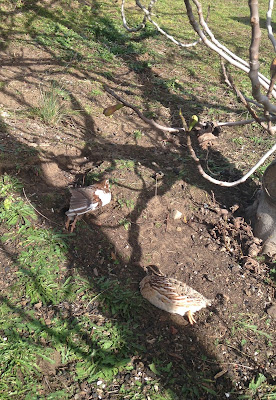If anyone can help...
Our last clutch (from one of our younger birds) hatched 7 eggs from a total of 21... We think other birds may have been laying in the nest, as the mother had started sitting once she reached about 11 eggs - but the number kept going up. All our other broody hens stopped laying once they started full-time sitting, so we are not exactly sure what was going on with this one.
The mother is quite wild, refusing to be hand-fed, and was very protective of her chicks, keeping well away from us and the other birds, and fluffing up to twice her size and hissing and growling if we came too close. Usually with newly-hatched chicks we feed them meal-worms, and give extra to the mother as well, but this one wanted nothing to do with us. Her chicks seemed very active, and she was a very vocal mother, calling to them constantly and keeping them close. We decided to leave her to it, as we've not had a great survival rate with chicks, despite our efforts to feed them and protect them.
At a week old the little family appeared to be thriving, and we were very pleased. Then the weather suddenly got cold. We went into the garden after a cold and wet night, and found one chick feebly calling, a second nearly frozen, and three dead in a huddled heap. The mother came running over asking to be fed, and the last two chicks were with her. We rushed the two cold ones up to the house and put them in the incubator to warm them up. The weaker one never recovered, and died after about 20 minutes. The second one initially looked much better, and started walking around, calling, and we were about to take it back to the mother. Then we noticed it appeared to be staggering, eventually it lay down, unable to lift its head, and then started twitching, and could barely move. Sadly, we decided to kill it, rather than watch it suffer.
The two surviving chicks are healthy - so far - and the mother now comes to be fed in the morning, but then takes her family and does her own thing, continuing to be aggressive to anyone who approaches.
So what happened?
At first we thought the cold killed them - but we can't understand why three were found dead and huddled together - if they were cold, and the mother had walked away, they would try to follow. We think they may have died under her.
The other two did appear to be trying to find her - and she'd been an excessively attentive mother up until then - why did she suddenly ignore them?
The one who seemed to recover, and then suddenly weakened again, despite being warm under the incubator - what happened there?
We wonder if they were sick, and that's why the mother abandoned them. Did she know they were too weak to survive? Could they have eaten something that poisoned them?
We've never had an experience like this one, and are at a loss to understand what happened. Can anyone help? Has anyone had chicks die suddenly, after a week running around and appearing to be strong and healthy?



























